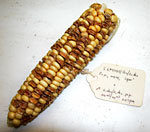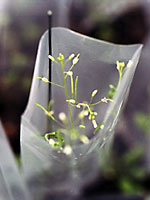|
|
|
Model
Organisms
|

|
Maize (
Zea mays
)
 Corn
is a classic model organism and an important crop plant. Together
with the fruit fly
Drosophila,
it was one of the first genetic
models, and many of the earliest important discoveries were made
with these two model organisms. With maize,
Barbara
McClintock
discovered "jumping genes" (genetic material
that can change its location on the genome), in part because she
could very clearly see the patterns of genetic traits carried in
the individual kernels.
Corn
is a classic model organism and an important crop plant. Together
with the fruit fly
Drosophila,
it was one of the first genetic
models, and many of the earliest important discoveries were made
with these two model organisms. With maize,
Barbara
McClintock
discovered "jumping genes" (genetic material
that can change its location on the genome), in part because she
could very clearly see the patterns of genetic traits carried in
the individual kernels.
On
maize as a model organism:
"One
of the advantages of corn is also that the endosperm of the kernel–the
juicy part you eat when you eat corn on the cob–is actually
extremely informative. Each kernel is the result of a different
cross, and so they will have different genetic properties. One of
the mutations that we look at, that we are interested in, is linked
to a mutation that causes this white kernel phenotype. So I can
just pick seeds that have this white endosperm, and I know that
they will be showing my mutant plant phenotype of interest."
—
Marja
Timmermans
, Research biologist, Cold Spring Harbor Laboratory
To learn more
about using corn (maize) as a model organism, visit the
Maize
Page
, published by the College of Agriculture at the University
of Iowa.
Wall cress (
Arabidopsis
thaliana
)
 Arabidopsis
thaliana
is a small flowering plant in the mustard family. It
has a very fast generation time, about six weeks, and was the first
plant to have its genome sequenced. It’s widely used to study
plant development, mutations, and basic biology. Relative to many other plants,
Arabidopsis
has a small number of genes, and they can be manipulated easily and quickly. Essentially a weed,
it’s easy to pollinate, generates lots of seeds, and can be
grown year-round.
Arabidopsis
thaliana
is a small flowering plant in the mustard family. It
has a very fast generation time, about six weeks, and was the first
plant to have its genome sequenced. It’s widely used to study
plant development, mutations, and basic biology. Relative to many other plants,
Arabidopsis
has a small number of genes, and they can be manipulated easily and quickly. Essentially a weed,
it’s easy to pollinate, generates lots of seeds, and can be
grown year-round.
On
Arabidopsis
as a model organism:
"The
combination of corn as a genetic organism and all the great advantages
it has as a genetic system, is very well supplemented with also
looking at
Arabidopsis,
which has a lot of molecular biology
and genomics tools available to us. These days, we like to actually
combine a variety of model species, and combine the advantages of
these two different systems together."
—
Marja
Timmermans
, Research biologist, Cold Spring Harbor Laboratory
To learn more
about using
Arabidopsis
as a model organism, visit
The
Arabidopsis Information Resource (TAIR)
.
|
|


 Corn
is a classic model organism and an important crop plant. Together
with the fruit fly
Drosophila,
it was one of the first genetic
models, and many of the earliest important discoveries were made
with these two model organisms. With maize,
Corn
is a classic model organism and an important crop plant. Together
with the fruit fly
Drosophila,
it was one of the first genetic
models, and many of the earliest important discoveries were made
with these two model organisms. With maize,
 Arabidopsis
thaliana
is a small flowering plant in the mustard family. It
has a very fast generation time, about six weeks, and was the first
plant to have its genome sequenced. It’s widely used to study
plant development, mutations, and basic biology. Relative to many other plants,
Arabidopsis
has a small number of genes, and they can be manipulated easily and quickly. Essentially a weed,
it’s easy to pollinate, generates lots of seeds, and can be
grown year-round.
Arabidopsis
thaliana
is a small flowering plant in the mustard family. It
has a very fast generation time, about six weeks, and was the first
plant to have its genome sequenced. It’s widely used to study
plant development, mutations, and basic biology. Relative to many other plants,
Arabidopsis
has a small number of genes, and they can be manipulated easily and quickly. Essentially a weed,
it’s easy to pollinate, generates lots of seeds, and can be
grown year-round.